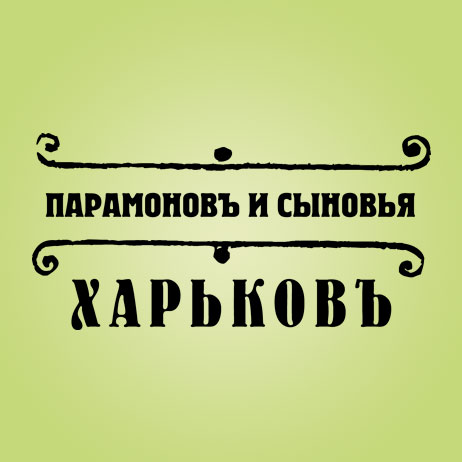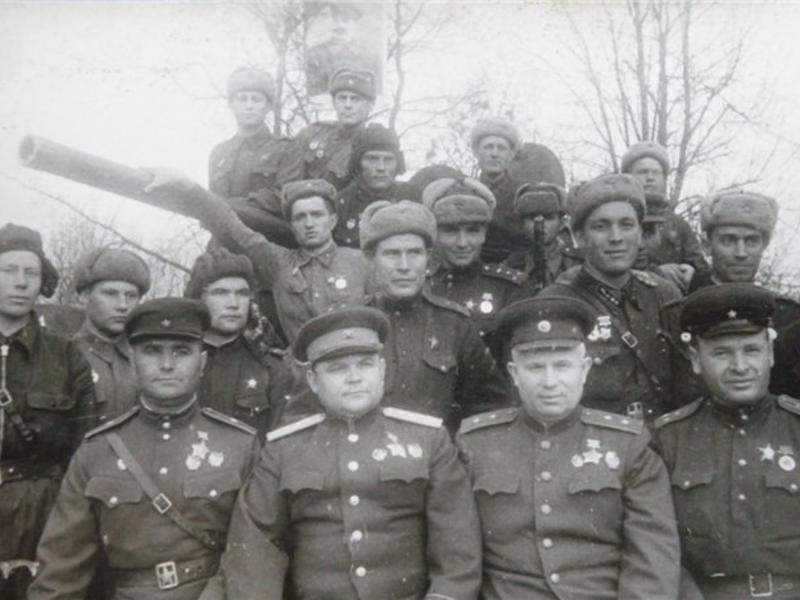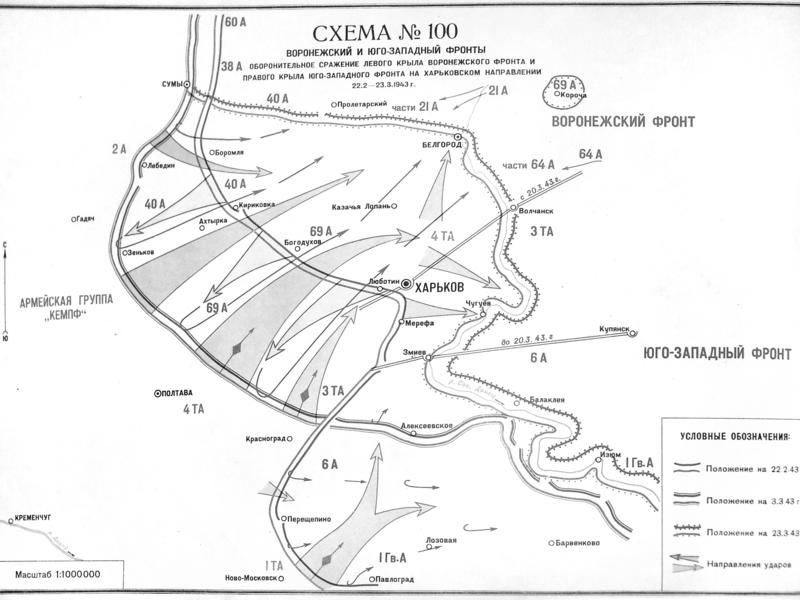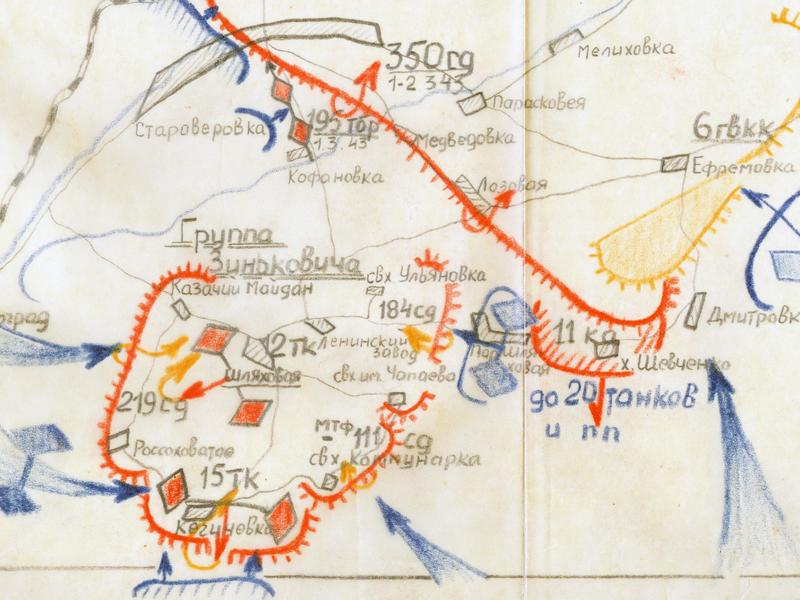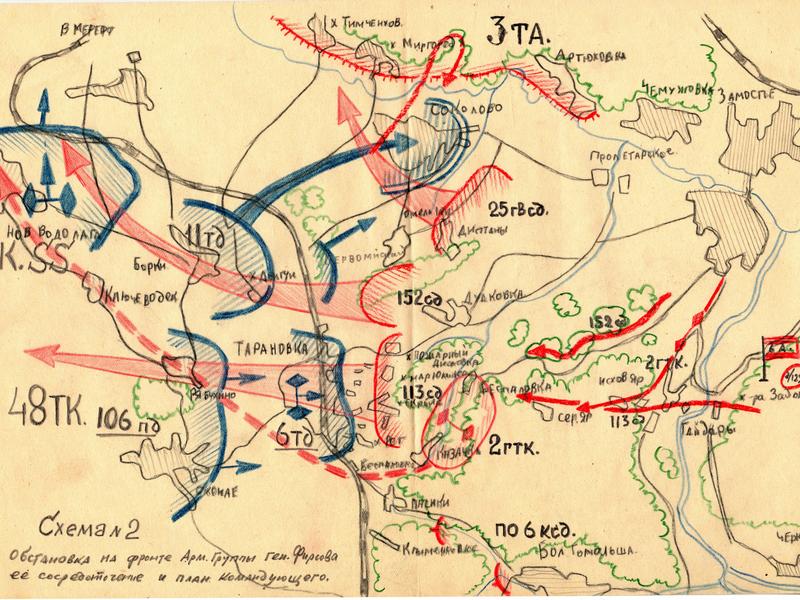General N.F.Vatutin
The Influence of Colonel General Vatutin on the Combat Operations near Kharkov in February – March 1943
According to the title of the article we will talk about the events on Voronezh front; Kharkov was situated in the attack line on February 1943 there; Colonel General Philip Ivanovich Golikov was a commander of this front. “What has this to do with the commander of Southwestern front Colonel General Nikolay Fyodorovich Vatutin?” – the surprised reader may ask. Some years ago I also thought this way and accused Colonel General Golikov and his deputy Lieutenant General Dmitriy Timofeyevich Kozlov of surrendering Kharkov in March 1943. The commander of Voronezh front can be accused of many things: he did not foresee the counterattack of SS tank corps and Kharkov surrender; however, neither General Headquarters nor General Staff of the Red Army did not foresee that. General Kozlov is usually accused of bad city preparation to defense. As it turned out the city was ready! Wehrmacht and Red Army documents prove this. On the other hand, there were not enough staff in the sub-units that defensed the city. Kozlov was slandered out of habit but there was another reason. The catastrophe near Kharkov had another but real culprit: Colonel General N.F.Vatutin…
In the previous articles together with the military historian Valeriy Bokhmyanin we have already mentioned (not even once!) the chain of negative moments concerning the commanding of Southwestern front by N.F.Vatutin and this has influenced the course of events and outcome for their neighbors: Voronezh front[1]. This small article summarizes the facts collected while researching the battles near Kharkov in February – March 1943. This article is not full, however, in my humble opinion, it can provoke the discussions among those who research the period of the Second World War.
Without repeating the course of the combat operations of both fronts as you may more or less know about them, we would like to stop on the several important and significant facts. All of them happened not in Voronezh but in the Southwestern front! The attack of the striking force of Lieutenant General Markiyan Michaylovich Popov was not stopped on time and as a result 4 tank corps and 3 infantry divisions of the Red Army were surrounded and almost fully destroyed. The 1st Guard army of this front commanded by Lieutenant General Vasiliy Ivanovich Kuznetsov lost the biggest part of its staff on the territory of current Barvenkovskiy, Lozovskoy and Sachnovshchinskiy districts of Kharkov region and Pavlogradskiy district of Dnepropetrovskiy region. Some army parts were cut off by the SS tank corps attack. The same happened to the 6th army commanded by Lieutenant General Fiodor Michaylovich Kharitonov on the territory of Pervomayskiy district of Kharkov region. Kharitonov was able to move parts of his army to the left bank of the river Severskiy Donets, however, they had no power to destroy the 4th tank army of Wehrmacht left on the right bank near the 48th tank corps. The weather and difficult relief helped them.
I will not discuss the conclusions the commander of the Southwestern front had to make; I will question what he did. Obviously the order to move the army to the left bank of the river Severskiy Donets, especially the 6th army, prevented them from the big losses. However they exposed the left flank of the 3rd tank army (commander Lieutenant General Pavel Semyonovich Rybalko) with only 6th Guard cavalry corps left there (commander Lieutenant General Sergey Vladimirovich Sokolov). Although this corps was reinforced with artillery regiments, antiaircraft and mortar batteries and tank brigade, it was exhausted by the battles near Merefa, Yefremovka, Bereki and Alekseyevka. The corps was not able to worthy resist the SS tank grenadier division “Das Reich”.
Colonel General Vatutin did not confine himself to withdrawal of forces over the river Severskiy Donets. By his request General Headquarters sent the 69th army of Voronezh front to the battles area of Vatutin’s army: from Poltava attack to Krasnograd – Karlovka. On February 28 1943, General Headquarters subdued the whole 3rd army from Voronezh to Southwestern front. At 10 pm the tankmen received an order to start flank attack onto the enemy that attacked Southwestern front.[2] Lieutenant General Rybalko had to unite the remains of his two tank corps with three infantry divisions and reinforcement parts and form a combat group under the commander of the 12th tank corps Major General Mitrofan Ivanovich Zinkovich. The group received its task personally from Vatutin! It was so far from reality that I wonder how that man got his position of the front army commander… The group of Zinkovich had to attack with tanks and - no less than – move to the area of village Orel of Lozovskoy district; they had to unite with the 1st Guard army and move to the east to Grushevacha, Mechebilovo, Knyaginin Liman. The distance of this operation for the weak 3rd tank army had to rise doubts among General Headquarters – but there were none! As a result the group was not able to attack the enemy and was surrounded near Kegichevka and almost fully destroyed.
The task for the 6th cavalry corps was also surprising. The combat group of Lieutenant General Sokolov united with infantry regiment and had to raid the enemy’s home fronts. Did Vatutin see the weather forecast for those days? The depth of snow on the road was in average 30-50 cm and somewhere almost 1 m! Did “strategist” Vatutin understand that in that weather conditions the cavalry had to dismount and infantry had to move half in snow? Did he know the state and real combat efficiency of this unity? It was not able to cross the front line and help the group of Zinkovich; and with the first enemy attack, it simply retreated. If Sokolov’s corps decided to defense it would have suffered big losses like for example in Alekseyevka and Yefremovka..
On March 3, 1943 at 24.00 Vatutin did not need exhausted 3rd tank army any more. Besides looking at the map, it was obvious that this army will have to defense Kharkov very soon. It was a “burden” without forces stuck in the battle and Vatutin did not want to bear responsibility for its actions[3]. He asked for these “non-tank tankmen” to be back to Voronezh front. Situation in the field of action of Rybalko army was difficult those days.
As you know the 3rd tank army created a defensive barrier along the river Mzha from the village Utkovka to the town Zmiyev: it was considered that SS tank corps will move to Kharkov by the shortest way either from Chuguyev (from the east, cutting from the river Severskiy Donets) or from Merefa (from the south). However, the enemy organized its attack with the help of three SS tank grenadier divisions considering the necessity to surround the city fully from the west and north. The 48th tank corps of Wehrmacht had to surround Kharkov from the south and east. This corps unexpectedly stuck near Taranovka and met there the 179th separate tank brigade and the 78th Guard infantry regiment. The planned beforehand movement of Germans to the joint of 3rd tank army and 6th army near Zmiyev through Sokolovo and Proletarskoye and near the village Mirgorody was stopped by 25th and 62nd Guard infantry divisions together with artillery, guard mortars and 1st separate Czechoslovak battalion.
Thanks to this, the position of 3rd tank army seemed not so hopeless. Besides, this could be strategic success when the reserves of General Headquarters come! According to Vatutin the fact that Taranovka was under the Red Army and on March 6, 1943 it was in the home front of the SS-men could have given a chance to attack the enemy and prevent Kharkov occupation. Combat group under the commander deputy of the Southwestern front Major General Pavel Andreyevich Firsov was created; Firsov himself subdued to the commander of 6th army. This group included two new infantry divisions (113 and 152) and famous after Stalingrad 2nd Guard Tatsinskiy tank corps commanded by Lieutenant General Vasiliy Michaylovich Badanov. These three units were fully staffed and equipped with heavy armament. Extra anti-aircraft and artillery regiments joined them. 25th Guard infantry division from the 3rd tank army became subdued to the 6th army and entered the group of Firsov. General Headquarters ordered the 3rd tank army to act according to the counterattack of Firsov’s groups. They expected a great success and it had to be success of Vatutin!
Generally speaking divisions’ movements from one army into another within the scope of one front is considered as necessity in the given situations. However, movement from one front into another was not necessary. As soon as 25th Guard infantry division became subdued to the 6th army of the Southwestern front, the commander of 3rd tank army Rybalko received a new task for 179th separate tank brigade and he moved it to the northern bank of the river Mzha near Mirgorody[4]. He was formally right: there was a risk of breach by the 6th Wehrmacht tank division but it was not so obvious (one tank battalion was even sent to Merefa). In fact, there was only exhausted 78th Guard infantry regiment left in Taranovka and when the Germans found out the possibility of Soviet counterattack from Taranovka, they easily captured the village. Such situation was possible only based on the negative relations with Vatutin. Rybalko cannot be accused of anything: he suspected that without taking the 179th tank brigade away from Taranovka, it would be the first to fight and would lose as well as 12 and 15 tank corps before that.
The chances for success of counterattack in the home front of SS tank corps were good; but for several “however”… the style and methods of commanding used by N.F.Vatutin interfered in the course of actions and other generals imitated them. There are many examples… Firsov’s group headquarters were situated in Mokhnach – in almost 40 km from Taranovka where his army concentrated. How could you command your units (including those that move and attack) from such distance? Especially when you need to make important decisions right on the battlefield? Working with Wehrmacht documents, I noticed that commander of the parts of German army General Hubert Lanz everyday (!) flew for the personal supervision of the situation and he often gave necessary orders right from the plane (!). Moreover, not only Lanz! All researchers know about the commander of SS tank grenadier division “Dead Head” Obergruppenfuhrer Theodor Eicke who died in the plane on March 4, 1943 to the south of Kharkov near the village Artelnoye. It was a norm for Hitler generals to supervise the positions of their armies.
The second moment I want to highlight is radio communication. During the battles days the circulation of documents in the Wehrmacht divisions increased manifold. During the day from 100 to 200 radiograms reported divisions and corps commanders about any changes in detachments and combat groups. Every two hours day air reconnaissance reported about changes right from the air – not the front commander or General Headquarters but directly corps and divisions commanders. Night air reconnaissance was also very active. That is why when 2nd Guard tank corps began to move to the front line, enemy’s air reconnaissance counted all its tanks and the route was known to the commander of SS 2nd tank corps and 48th tank corps. Commander of Wehrmacht 4th tank army Colonel General Got and commander of army groups “South” Feldmarchall Manstein knew about possible Soviet counterattack on March 8, 1943. That is why on March 9 Wehrmacht 6th tank division with the help of SS battalion grenadier division “Dead Head” occupied Taranovka. Only the eastern part of the village was under 78th Guard infantry regiment[5].
Nevertheless, Firsov’s group still attacked later (with a delay of all parts) and it was not attack of Taranovka by tank corps but they had to liberate the village this time. Only after that they could move to Novaya Vodolaga into SS home front. It was also obvious that infantry subdivisions were not able to retake Sokolovo occupied by the Germans; that is why the remains of 18th tank corps commanded by Major General Boris Sergeyevich Bakharov (from the destroyed groups of General Popov) were sent to Sokolovo. At that time the corps included 170th tank brigade (20 tanks) and 32nd motorized infantry brigade that was reinforced with staff and heavy armament.
On March 9, 1943, the first attempts to clean Taranovka and Sokolovo from the Germans were unsuccessful. There should have been the group commander Major General Firsov, however, he was far from the battlefield. At night it was decided to attack with the help of 2nd Guard Tatsynskiy tank corps and infantry divisions. It was decided but not fulfilled.. Early in the morning the tankmen attacked earlier than it was planned and they did not inform anyone. They were alone without infantry! 113th infantry division moved to help as soon as it could, however, the Germans quickly understood the situation and did not give opportunity to support the attack. The tankmen had to retreat with great losses…
At first, I thought that Vatutin could have provoked such course of actions by saying to Badanov: guardsman, show us how to fight! After examining the history of 2nd Guard tank corps I realized that its losses in the village Tatsynskaya in December 1942 were connected with the German 6th tank division of 48th tank corps. Near Kharkov Badanov and his tankmen met their “offender” that occupied Taranovka. Hitlerite was not punished again… the following excuses of Badanov looked stupid: the attack was unsuccessful because his 11 tanks stuck in the bog near Taranovka[6]. Seriously? Damned bog…Neither Soviet 179th separate tank brigade nor Wehrmacht 48th tank corps lost there any tanks in such a strange way. Local bogs did not disturb them from defense and attack …
At 10 am that day Firsov’s groups received an order to stop counterattack: finally it was obvious that the enemy wanted to surround Kharkov from the north and east with the help of 2nd SS tank corps. Furthermore, the enemy moved to the suburbs and was going to storm the city! There was no sense to fight for Taranovka and hope for doubtful success in attacking Novaya Vodolaga: they could not safe the city from surrounding. Kharkov needed the Guard tank corps but it lost half of its tanks in the battle, “in the bog” and while moving it left 68 tanks with different breakdowns!!!
After such losses, 2nd Guard tank corps easily went to Voronezh front: maybe Golikov will be more lucky? The situation with 3rd tank army was ambiguous. On the one hand, this army was part of Voronezh front and commander Rybalko sent all his reports to commander Golikov. On the other hand, in the documents of Southwestern front in March 1943 this 3rd tank army appeared as part of this (Vatutin) front. At the same time all mistakes and negative actions in Kharkov defense were automatically recorded (let us honestly say shifted) onto 3rd tank army: “But for Rybalko, everything would be differently…” You can see an example of this in the report about combat action of Southwestern front artillery in March 1943.
Reasonable question: why did General Headquarters and General Staff tolerate the “torment” of 3rd army? Why didn’t they interfere and insist on using the staff and equipment they had more effectively and wisely but not to Vatutin’s mind? Southwestern front had opportunities and reserves to create a combat group as part of the new tank corps, two infantry divisions, up to ten artillery regiments for different purposes. It would have been better to send them for direct strengthening of Kharkov defense and not into doubtful risky ventures of the strategist. Maybe they wouldn't have to surrender Kharkov…
I am not describing the following events as after the end many famous commanders wallowed in mutual accusation and as a result Golikov and Kozlov suffered. Vatutin’s role in Kharkov surrender in the war and post-war times has never been discussed. Unfortunately, many participants of the battles especially from the groups of Popov, Zinkovich and Firsov, in ranks of corps, divisions and brigades commanders who broke out of encirclement and possessed any information of those events, either died during the war or didn’t live till the time when they could tell about those days in memoirs or reminiscences. Battles participants and their descendants would be interested in knowing the opinion of colonel Ziberov, Koyda, Major General Kotelnikov, Zinkovich, Koptsov, Makovchuk, Alyekhin, Bakharov and many others whose front truth is left unsaid…
[1] V.Vokhmyanin, A.Paramonov. Shyronintsy: exploit without caesura. – Kh. “KkChMGU”. – 2014. – 120 p.; V.Vokhmyanin, A.Paramonov. Sokolovo: forgotten heroes. – Kh. “KkChMGU”. – 2014. – 116 p.
[2] State Archives of Department of Defense of the Russian Federation. – F.316, list 4487, unit of issue 66. – L. 68.
[3] State Archives of Department of Defense of the Russian Federation. – F.316, list 4487, unit of issue 66. – L. 74.
[4] State Archives of Department of Defense of the Russian Federation. – F.316, list 4487, unit of issue 101. – L. 344.
[5] [5] National arhiv microkopy. – Т. 315. – Roll 348. – 142.
[6] State Archives of Department of Defense of the Russian Federation. – F.3400, list 1, unit of issue 32. – L. 69

